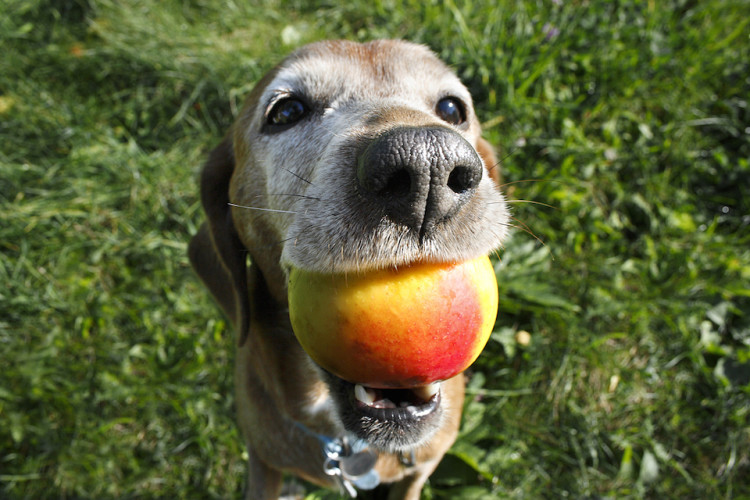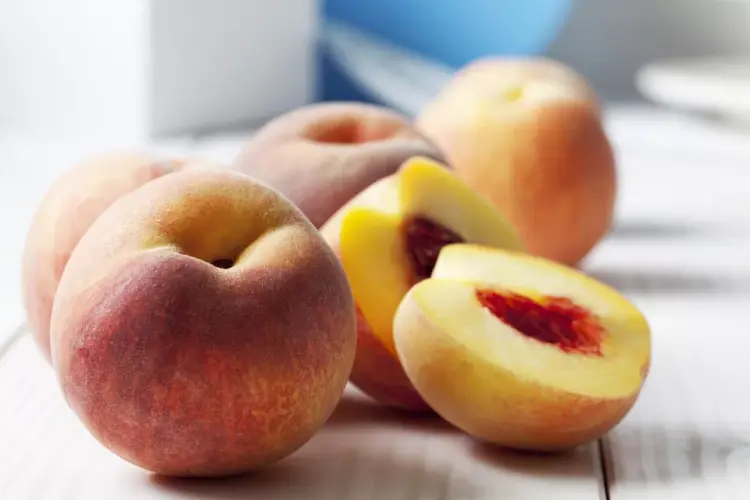The answer is yes, dogs can eat peaches but only when served properly and in moderate amounts. Although this fruit is packed with nutrients that can be beneficial to your pup’s health, too many peaches can cause diarrhea and upset stomach. The pits can also present a choking hazard or cause intestinal obstruction, so you need to be very careful.
Here’s everything you need to know about feeding peaches to your dog.
Table of Contents:
- Health benefits of peaches for dogs
- When are peaches bad for dogs?
- Can dogs have peach pits?
- Can dogs eat peach yogurt?
- Can dogs eat peach jam?
- How to feed peaches to your dog
- Key Takeaways
Pro tip: Signing up for pet insurance when your pup is young is the best way to prepare for health problems they might experience throughout their life. Getting insurance early on also significantly reduces the overall cost of the dog’s emergency care because there are fewer pre-existing conditions.
Health benefits of peaches for dogs
Peaches offer many health benefits that dogs can enjoy along with their favorite humans. Here are some of the most important ones:
-
Vitamins and minerals. These popular summer fruits are rich in vitamin A, C, and E. Vitamin A is essential for maintaining healthy skin, whereas vitamin C strengthens the immune system. Vitamin E is one of your pup's defenses against oxidative damage and also essential for fat metabolism and cell function. Vitamin E deficiency can result in muscle and eye degeneration, as well as in reproductive problems. In addition to these vitamins, peaches also contain minerals such as manganese, phosphorus, potassium, and copper.
-
Disease prevention. Peaches are packed with antioxidants that help defend cells from harmful free radicals, protecting the body from cancer.
-
Digestive health. Peaches have high dietary fiber content, which helps in digestion and reduces the likelihood of constipation for dog.
-
Heart health. Peaches are a good source of potassium, which the body uses to regulate blood pressure by eliminating excess sodium and relaxing tension in the blood vessel walls. Peaches can also improve your dog’s heart health by binding the cholesterol and bile acids.
 (Image source: Dog Carion)
(Image source: Dog Carion)
When are peaches bad for dogs?
Dogs don’t need to eat fruit to achieve a well-balanced diet, but a few peach slices are a perfectly safe and delicious treat that many dogs enjoy. However, there are some rules that pet parents need to follow to make sure they stay on the safe side.
-
Avoid feeding your four-legged pal whole peaches. These sweet fruits are high in natural sugars and quite acidic, which means that 2-3 slices are more than enough.
-
Due to the high sugar content, peaches are higher in calories than some other fruits. One fresh peach contains about 8% sugar, and one cup of sliced peach has about 60 calories and 13 g of sugar. Too many peaches can cause stomach upset and increase the risk of obesity in dogs.
-
Try to only feed their pets organic peaches. Non-organic fruits are treated with pesticides that can easily permeate the thin outer skin. However, regardless of whether you give your dog organic or non-organic peaches, be sure to wash them well before feeding.
-
Make sure to inspect the peaches for mold before serving them to your canine best friend. Moldy fruits can cause GI upset, liver failure, or even seizures. Also, spoiled fruit ferments and turns the sugar into alcohol. Even small amounts of alcohol — not only in drinks but also in raw bread dough, syrups, and spoiled fruits — can have ingredients that are poisonous for them.
Can dogs have peach pits?
Unlike a dog eating watermelon seeds, stone fruits such as plums, apricots, cherries, and peaches can be bad for your pup. Not only do they present a choking hazard, but the pit (also called peach stone) contains amygdalin, a toxic cyanogenic compound that might cause health problems in high amounts. Of course, it takes much more than a single pit to cause serious issues but it’s always better to be safe than sorry. Amygdalin is present in the peach leaves and stems as well.
If your dog ingests these parts of the fruit, monitor them to see if there are any changes in behavior. Contact your vet right away if they show the following signs of cyanide toxicity:
- Appetite loss
- Abdominal pain
- Diarrhea
- Dilated pupils
- Difficulty breathing
- Gagging
- Vomiting
- Lethargy
- Severe panting
- Regurgitation
- Red gums
The hard center can also damage or break your dog’s teeth, causing painful fractures into the nerves, whereas the sharp and rigid texture of the pits can damage the lining of the throat and stomach.
Finally, ingested pits can cause intestinal blockages, requiring surgery for removal.
Pro tip: Accidents like this would be covered with a pet insurance plan in effect. Having pet insurance before a diagnosis can significantly help reduce unexpected expenses for emergency surgery.
 (Image source: The Spruce Pets)
(Image source: The Spruce Pets)
Can dogs eat peach yogurt?
Store-bought peach yogurt usually contains artificial flavors and preservatives, which can be bad for your canine companion. Yogurt of any kind can be problematic for dogs that are lactose intolerant.
If you want to give your dog peach yogurt, the best option is to prepare it yourself by combining plain yogurt and organic peaches. Be sure to give your pet a little bit of yogurt first to see if their body can digest it. If they look uneasy, it’s better to not feed them any type of yogurt again.
If everything seems okay and you decide to treat your pup to some peach yogurt, you should still make sure that the amount is minimal and won’t affect their health.
Can dogs eat peach jam?
Feeding dogs jam can be dicey. Processed jams are usually high in sugar which can cause stomach upset. Too much sugar over time can also cause diabetes, obesity, and rot your pet’s teeth. What’s more, some jams contain artificial sweeteners like xylitol which can be extremely toxic to dogs.
How to feed peaches to your dog
If you want to treat your four-legged friend to some peaches, apply the 10% rule recommended by vets: treats, including fruits and vegetables, can make up no more than 10% of the calories in your pet’s diet.
Be sure the peaches are free of mold and rot. Wash them thoroughly, cut them into small pieces, and remove the pits, leaves, and stems. If you want to get more creative, here are some serving ideas to help you out:
- You can mix peach slices with other dog-safe fruits like bananas and apples for a sweet treat.
- Frozen peaches also make a refreshing treat, especially on summer days.
- Add diced peaches and a teaspoon of all-natural peanut butter to your dog’s oatmeal.
- Dice a few peach slices into small cubes and combine them with some plain Greek yogurt (if your dog is lactose-tolerant). Pour the mixture into an ice cube tray and put it in the freezer. Serve as a cool snack on hot days.
- Make peach dog biscuits. Boil one peach for about a minute, then cool it in an ice bath. Remove the pit and skin, and blend until smooth. Mix ¼ cup blended peach with a cup of whole wheat flour, a dash of cinnamon, and a teaspoon of honey. Knead to form a dough, then roll it out and cut it into shapes. Bake at 350 degrees for about 20 minutes.
NOTE: Don’t feed your pup preserved or canned peaches. These are high in added sugars and contain preservatives, both of which can cause stomach upset.
You should always speak to your vet before giving your pooch any kind of human food. Certain health conditions could be worsened by peaches or other foods, so it’s best to be sure before feeding them to your pet. The vet will be able to tell you how many peaches to feed your dog in each serving.
Key Takeaways
- As with other human foods, moderation is key when it comes to feeding peaches to your dog, so serve them as an occassional treat.
- Start with a small amount to make sure that no tummy upset occurs. If everything seems okay, you can increase the amount but keep the 10% rule in mind due to the high sugar and acid in peaches.
- If you spot that your pup has difficulty breathing, develops hives, or starts coughing after eating a peach, be sure to speak to your vet.
